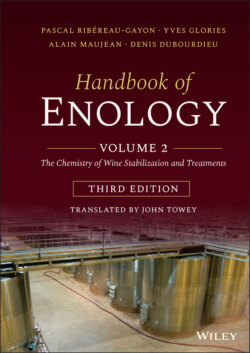Читать книгу Handbook of Enology, Volume 2 - Pascal Ribéreau-Gayon - Страница 41
1.7.4 Rapid Cold Stabilization: Dynamic Continuous Contact Process
ОглавлениеUnlike the preceding “batch” technology, the process described in Figure 1.17 is a continuous bitartrate stabilization process, where the length of time the crystals are in contact with the wine, i.e. the treatment time, is defined by the throughput in relation to the volume of the crystallizer. Thus, for example, if the throughput is 60 hl/h and the volume of the crystallizer is 90 hl, the average time the wine spends in the system is 1 hour 30 minutes.
This emphasizes the need for a method of monitoring effectiveness with a very short response time. There is, of course, a system for recycling wine through the crystallizer if the treatment is insufficiently effective, but the results must be determined very rapidly, as the energy required to treat these quantities of wine is expensive, and unnecessary extra treatment will by no means improve quality.
Continuous treatment is understandably more demanding than the other processes, because it requires close monitoring, but it is also more efficient. For example, the particle size of the contact tartrate and the level in the crystallizer must be monitored by sampling after a few hours, using the drain system.
FIGURE 1.17 Schematic diagram of a continuous cold stabilization system: 1, intake of wine to be treated; 2, heat exchanger; 3, refrigeration system (with compressor, condenser, etc.); 4, insulation; 5, mechanical agitator; 6, recycling circuit (optional); 7, outlet of treated wine; 8, filter (earth); 9, drain; 10, overflow.
Agitation is partly provided by a tangential input of wine into the crystallizer. This creates turbulence in the bulk of the liquid and maintains at least the smallest crystals in suspension. The wine may also be mechanically agitated.
The throughput, i.e. the average time in the crystallizer, is defined according to the wine's initial state of supersaturation, as well as the type of preparatory treatment (fining, bentonite, etc.) received prior to artificial cold stabilization. The importance of preparation has already been mentioned (Section 1.6.4).
The effectiveness of the three processes described above is generally satisfactory, although results depend on the type of wine (white or red), its alcohol content, and any previous treatment or fining.
It is true that, in contact treatments involving large‐scale seeding, the wine's background is less important. Indeed, enologists do not always have this information if the wine has been purchased from another winery. In any event, wine must be well prepared and, above all, properly clarified to ensure the effectiveness of rapid artificial cold stabilization treatments.
